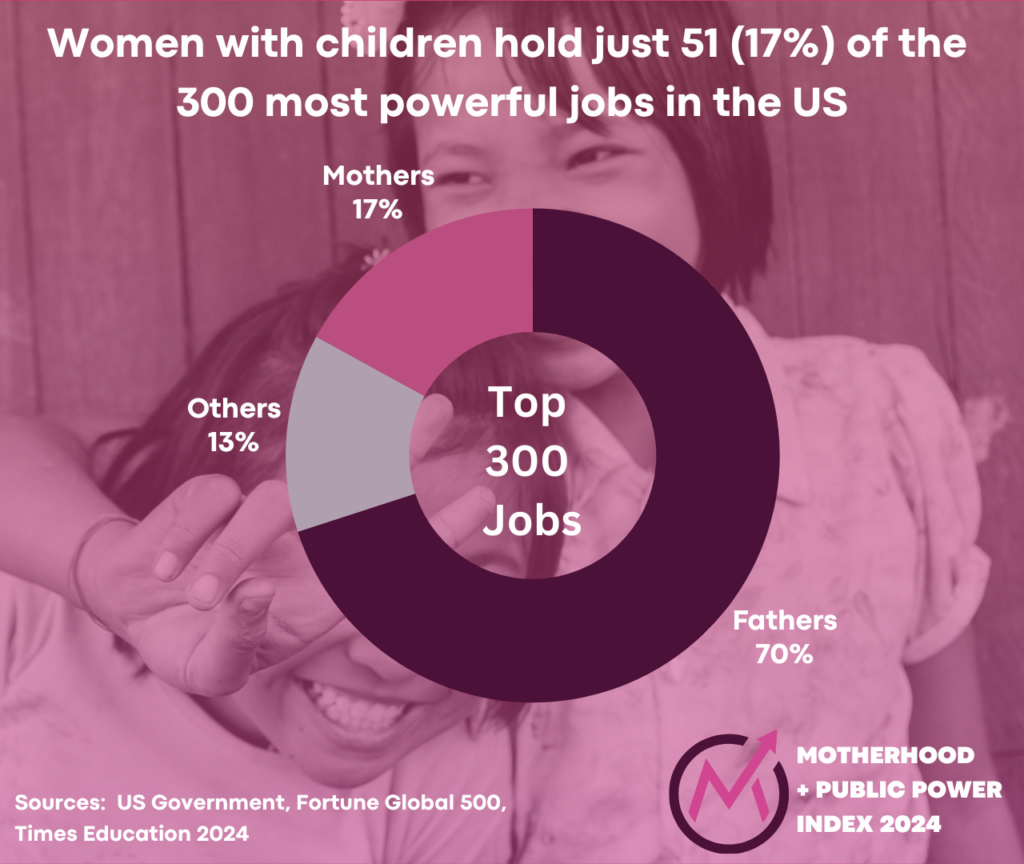Motherhood + Public Power Index
Motherhood and public power
Published 8 March 2024 for International Women’s Day
The quality of leadership in the most powerful nation in the world matters. Despite governing only 5% of the world’s 8 billion citizens, the USA’s economic, political, and social power and influence shapes growth and development in most of the world’s nations. And with a new set of ambitious global goals to achieve, including ending poverty and hunger, increasing lifespans, universal high school graduation, gender equality, and much more by 2030, the USA will need its very best talent at the helm of it’s most powerful institutions – government, businesses, and universities – to sustain that global influence.
In this context, the results of the 2024 Motherhood+Public Power Index can only be described as deeply disturbing. Just 17% (51) of the 300 most powerful positions in the USA are held by women with children. In contrast, 71% (213) of the top 300 jobs are held by fathers. The remaining 12% (37) are held by men and women without children. Even more concerning, of the 51 mothers in power, just 11 have children under 18 years of age. In contrast, of the 213 fathers in power, 61 have children under 18. Put another way, there are more than five times as many fathers with children under 18 holding the most powerful jobs in the USA compared to women with children under 18.
Of the three sectors measured by the Motherhood+Public Power Index – government, business, and academia – government performs best in promoting leaders who are also mothers into the top jobs. There are 23 (23%) mothers holding the top 100 jobs in the US Cabinet, Congress, and among Governors. In contrast, there are 20 (20%) mothers leading top US universities, and just eight (8%) mothers leading the top 100 companies.
The conclusion could not be clearer – mothers are dramatically underrepresented in the halls of power in the US, while fathers are dramatically overrepresented. In short, having children is a barrier to public power and influence for only one gender. If the USA had the same proportion of mothers leading their most powerful institutions as they do in the population (40%), we would expect to see 120 mothers in the top jobs in the USA, an increase of 69 on the current 51.
What can be done to accelerate the proportion of women who are also mothers into four out of every 10 top leadership positions? First, we need to celebrate and support the mothers already in powerful positions (see the list of the 51 most powerful mothers in the USA below). We should all know their names.
Second, we all need to push for the changes that would make it easier for more mothers to pursue their professional careers to the levels of highest influence across government, business, and academia. Primarily this will involve a profound transformation in work norms so that workplaces deliver on the “deep and temporal flexibility” championed so powerfully by Anne-Marie Slaughter, Claudia Goldin, and Joan Williams.
Third, we need to build a truly global movement to put more mothers into seats of power. It’s not enough if the USA increases the proportion of mothers in the top power positions. We need countries like India, China, lndonesia, Pakistan, Nigeria, Brazil, Russia, Japan, and Egypt advancing motherhood and public power – measuring it, publicly reporting on it, and ultimately putting in place the policies and programs that will achieve a critical mass of mothers in positions of public influence everywhere.
The world can no longer afford to pay the high price it has been paying for the underrepresentation of women with children in leadership positions. In the 21st century we need the very best leaders at the helms of our most powerful institutions and nations – people who truly reflect the diversity of skills, talents, experiences, and values in our populations.
Know their names: the 51 most powerful mothers in the USA
Government (23)
- Janet Yellen, Central Bank
- Deb Haaland, Secretary of the Interior, US Cabinet
- Gina Raimondo,* Secretary of Commerce, US Cabinet
- Julie Su, Secretary of Labor, US Cabinet
- Jennifer Granholm, Secretary of Energy, US Cabinet
- Linda Thomas-Greenfield, UN Ambassador
- Isabel Guzman, Secretary for Small Business, US Cabinet
- Shalanda Young, Office of Management and Budget
- Arati Prabhakar, Office of Science and Technology
- Patty Murray, Senator
- Debbie Stabenow, Senator
- Elizabeth Warren, Senator
- Amy Klobuchar, Senator
- Joni Ernst, Senator
- Shelly Moore Capito, Senator
- Elise Stefanik,* Congress
- Katherine Clark, Congress
- Kay Granger, Congress
- Virginia Foxx, Congress
- Cathy McMorris Rogers,* Congress
- Kathy Hochul, Governor
- Gretchen Whitmer, Governor
- Katie Hobbs, Governor
- Business (8)
- Mary Barra, General Motors
- Gail Boudreaux, Elevance Health
- Sarah London,* Centene
- Priscilla Almodovar, Fannie Mae
- Jane Fraser, Citigroup
- Carol Tomé, UPS
- Tricia Griffith,* Progressive
- Corie Barry,* Best Buy
Universities (20)
- Sally Kornbluth, MIT
- Carol Christ, UC Berkeley
- Minouche Shafik, Columbia
- Martha Pollack, Cornell
- Jennifer Mnookin, University of Wisconsin-Madison
- Christina Paxson, Brown
- Carol Folt, USC
- Rebecca Cunningham,* University of Minnesota Twin Cities
- Neeli Bendapudi, Pennsylvania State University
- Sarah Mangelsdorf, University Rochester
- Joan Gabel,* University of Pittsburgh
- Sean Beilock,* Dartmouth
- Pamela Whitten, Indiana University
- Cynthia Larive, University of California Santa Cruz
- Marie Lynn Miranda, University of illinois
- Barbara Wilson, University of Iowa
- Rhea Law, University of South Florida
- Maurie McInnis,* Stony Brook University
- Radenka Maric, University of Connecticut
- Amy Parsons,* Colorado State University
* One of 11 female leaders with children under 18 years of age
The Motherhood+Public Power Index uses the latest data from official US Government House and Senate websites, the Fortune 500 2024, and the World University Rankings 2024.



